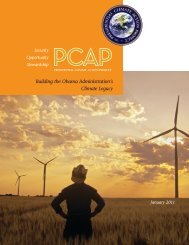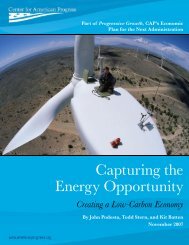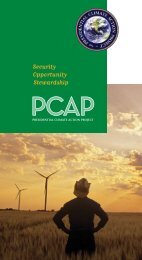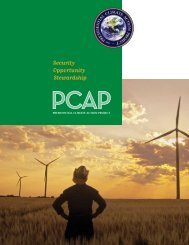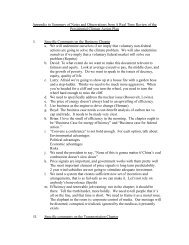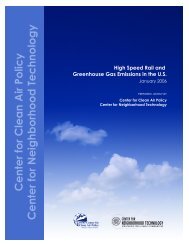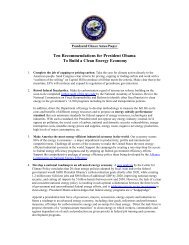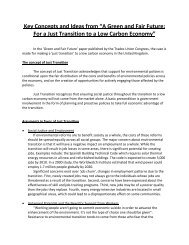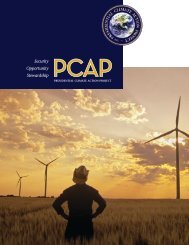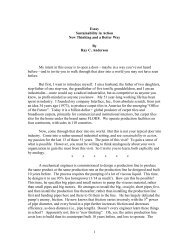PCAP - Presidential Climate Action Project
PCAP - Presidential Climate Action Project
PCAP - Presidential Climate Action Project
- No tags were found...
Create successful ePaper yourself
Turn your PDF publications into a flip-book with our unique Google optimized e-Paper software.
Direct the EPA to immediately begin regulating GHG emissions under the Clean Air Act.B-07Because there are no comparable greenhouse gas trading systems in place, experts are unsure ofhow successful the architecture will be or how soon its effects will appear in the marketplace.Some estimate that it will take a decade or more; others predict faster results. To ensure neartermemission reductions and to provide a safety net for the atmosphere, the President shouldorder the EPA to expedite its determination that all greenhouse gas emissions meet the criteriafor regulation under the Clean Air Act. <strong>PCAP</strong> Report 2:6.Background. Regulation of GHGs under the CAA is the subject of Chapter VIII of theBoundaries Report. As a preliminary matter to be subject to regulation under the CAA, asubstance must fall within the statutory definition of “air pollutant.” The EPA has maintainedthat GHGs are not air pollutants and therefore has not regulated GHG emissions under the CAA.However, in August 2007, the Supreme Court ruled in Massachusetts v. EPA that GHGs are airpollutants as defined by the CAA. 192Statutes. To trigger regulation under the CAA, the EPA must find that a “pollutant” causes orcontributes to “air pollution which may reasonably be anticipated to endanger public health orwelfare; the presence of which in the ambient air results from numerous or diverse mobile orstationary sources . . . .” 193 If this finding is in the affirmative the substance is put on the airpollutant list. Once on the list, EPA regulates these substances through: (1) air quality standards;(2) stationary source standards; and (3) mobile source standards. It seems fairly clear based onthe recital of scientific evidence in the Supreme Court decision and on the report released by theU.S. <strong>Climate</strong> Change Science Program on May 29, 2008, Scientific Assessment of the Effects ofGlobal Change on the United States, 194 that a finding that GHG emissions endanger publichealth or welfare is unavoidable. However, there is a timing issue.In the relevant provisions of the CAA, the EPA is required to revise pollutant lists and standards“from time to time.” 195 Further, the Supreme Court held, in Massachusetts v. EPA, that “EPA nodoubt has significant latitude as to the manner, timing, content, and coordination of itsregulations with those of other agencies.” 196 Subsequent direction by the current administrationlacks timeframes or specifics as to the action EPA should take, and the EPA Administrator, in aletter dated March 27, 2008 to Senators Boxer and Inhofe, announced the Agency’s intent tomerely accept public comment rather than make an endangerment finding at this point. 197 Thus,192 Massachusetts v. EPA, 127 S.Ct. 1438.193 42 U.S.C. § 7408(a)(1).194 See Chapter II for a summary of the findings.195 E.g., 42 U.S.C. § 7408(a)(1) (list); 42 U.S.C. § 7411(b)(1)(A) (stationary sources); 42 U.S.C. § 7521(a)(1)(mobilesources).196 Massachusetts v. EPA, 127 S.Ct. at 1462.197 Bush Calls for Cuts in Vehicle Emissions: Agencies Ordered to Draft New Rules, WASH. POST, May 15, 2007, atD1; Charlie Savage and Robert Pear, White House Sets a June Deadline to Propose Rules, N.Y. TIMES, May 31,CEES 45 | P age



